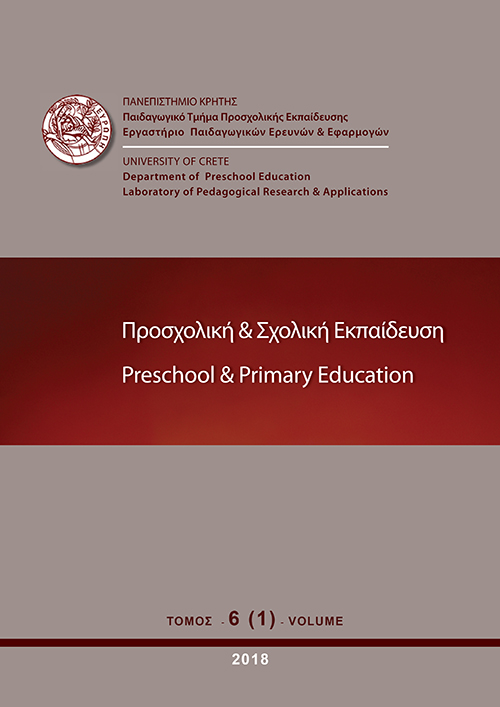Playful Interactions between Twins with Autism and Teachers and Peers: a Case Study
Περίληψη
Σκοπός της παρούσας αναλυτικά δομημένης εμπειρικής μελέτης ήταν η διερεύνηση των αλληλεπιδράσεων των διδύμων στα πλαίσια του παιχνιδιού τους με δασκάλους και συνομηλίκους σε ένα τμήμα Ειδικού Νηπιαγωγείου. Οι συμμετέχοντες ήταν ένα ζεύγος δίδυμων αγοριών με Διαταραχή Αυτιστικού Φάσματος (ΔΑΦ), ηλικίας 5.5 ετών, δύο νηπιαγωγοί και επτά συνομήλικοι μη-τυπικά αναπτυσσόμενοι. Παρατηρήσαμε για τέσσερις συνεχόμενες εβδομάδες, από μία ημέρα την εβδομάδα, διαφορετική κάθε φορά, τη συχνότητα και τη διάρκεια των παιγνιωδών αλληλεπιδράσεών τους, καθώς και τις πρωτοβουλίες που έπαιρναν οι συμμετέχοντες. Τα αποτελέσματα που προέκυψαν από τις βιντεοσκοπήσεις και τα αρχεία του σχολείου, δείχνουν ότι τα δίδυμα αδέλφια με αυτισμό παίρνουν πρωτοβουλίες προκειμένου να αλληλεπιδράσουν στο δυαδικό τους παιχνίδι με τους μη-τυπικά αναπτυσσόμενους συνομηλίκους, παρόλο που δεν πρόκειται για αλληλεπιδράσεις μεγαλύτερης διάρκειας. Ωστόσο, δεν παίρνουν καμία πρωτοβουλία στις δυαδικές αλληλεπιδράσεις με τους δασκάλους τους. Επίσης, υπάρχουν ενδείξεις ότι τα δίδυμα αδέλφια εμπλέκονται περισσότερο σε αλληλεπιδραστικό παρά σε μοναχικό παιχνίδι. Τα αποτελέσματα αποτελούν σημείο αφετηρίας για μια νέα προσέγγιση της κατάστασης της διδυμίας και της εξαιρετικά μεγάλης ετερογένειας στην αιτιολογία της ΔΑΦ στη βάση της θεωρίας της έμφυτης διυποκειμενικότητας.
Λεπτομέρειες άρθρου
- Πώς να δημιουργήσετε Αναφορές
-
Kypriotaki Μ. A., & Markodimitraki, M. E. (2018). Playful Interactions between Twins with Autism and Teachers and Peers: a Case Study. Preschool and Primary Education, 6(1), 1–22. https://doi.org/10.12681/ppej.11445
- Τεύχος
- Τόμ. 6 Αρ. 1 (2018)
- Ενότητα
- Άρθρα

Αυτή η εργασία είναι αδειοδοτημένη υπό το CC Αναφορά Δημιουργού – Μη Εμπορική Χρήση – Παρόμοια Διανομή 4.0.
Οι συγγραφείς των άρθρων που δημοσιεύονται στο ΠΡΟΣΧΟΛΙΚΗ & ΣΧΟΛΙΚΗ ΕΚΠΑΙΔΕΥΣΗ διατηρούν τα δικαιώματα πνευματικής ιδιοκτησίας επί των άρθρων τους, δίνοντας στο περιοδικό το δικαίωμα της πρώτης δημοσίευσης. Άρθρα που δημοσιεύονται στο ΠΡΟΣΧΟΛΙΚΗ & ΣΧΟΛΙΚΗ ΕΚΠΑΙΔΕΥΣΗ διατίθενται με άδεια Creative Commons 3.0 και σύμφωνα με την άδεια μπορούν να χρησιμοποιούνται ελεύθερα, με αναφορά στο/στη συγγραφέα και στην πρώτη δημοσίευση για μη κερδοσκοπικούς σκοπούς και με δικαίωμα τροποποίησης μόνον με παρόμοια διανομή (αν αναμείξετε, τροποποιήσετε, ή δημιουργήσετε πάνω στο υλικό, πρέπει να διανείμετε τις δικές σας συνεισφορές υπό την ίδια άδεια όπως και το πρωτότυπο). To Εργαστήριο Παιδαγωγικών Ερευνών και Εφαρμογών του Παιδαγωγικού Τμήματος Προσχολικής Εκπαίδευσης του Πανεπιστημίου Κρήτης και το Εθνικό Κέντρο Τεκμηρίωσης διατηρούν το δικαίωμα να δημοσιεύουν, να αναπαραγάγουν, να παρουσιάζουν στο κοινό, να διανέμουν και χρησιμοποιούν άρθρα που δημοσιεύονται στο ΠΡΟΣΧΟΛΙΚΗ & ΣΧΟΛΙΚΗ ΕΚΠΑΙΔΕΥΣΗ σε οποιοδήποτε μέσο και μορφή είτε μεμονωμένα είτε ως μέρη συλλογικών έργων, για όλο το χρόνο διάρκειας προστασίας της πνευματικής ιδιοκτησίας και για όλες τις χώρες του κόσμου. Αυτό περιλαμβάνει ενδεικτικά και όχι αποκλειστικά, το δικαίωμα δημοσίευσης των άρθρων σε τεύχη του περιοδικού ΠΡΟΣΧΟΛΙΚΗ & ΣΧΟΛΙΚΗ ΕΚΠΑΙΔΕΥΣΗ, αναπαραγωγής και διανομής μεμονωμένων αντιγράφων των άρθρων, αναπαραγωγής ολόκληρων των άρθρων σε άλλη έκδοση του Εργαστηρίου Παιδαγωγικών Ερευνών και Εφαρμογών του Παιδαγωγικού Τμήματος Προσχολικής Εκπαίδευσης του Πανεπιστημίου Κρήτης και του Εθνικού Κέντρου Τεκμηρίωσης και αναπαραγωγής και διανομής των άρθρων ή περίληψης αυτών με χρήση πληροφορικού συστήματος αποθετηρίου.



